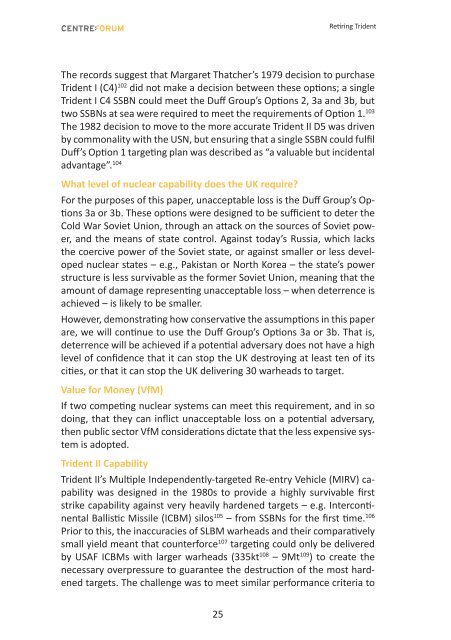Retiring Trident
retiring-trident
retiring-trident
Create successful ePaper yourself
Turn your PDF publications into a flip-book with our unique Google optimized e-Paper software.
<strong>Retiring</strong> <strong>Trident</strong><br />
The records suggest that Margaret Thatcher’s 1979 decision to purchase<br />
<strong>Trident</strong> I (C4) 102 did not make a decision between these options; a single<br />
<strong>Trident</strong> I C4 SSBN could meet the Duff Group’s Options 2, 3a and 3b, but<br />
two SSBNs at sea were required to meet the requirements of Option 1. 103<br />
The 1982 decision to move to the more accurate <strong>Trident</strong> II D5 was driven<br />
by commonality with the USN, but ensuring that a single SSBN could fulfil<br />
Duff’s Option 1 targeting plan was described as “a valuable but incidental<br />
advantage”. 104<br />
What level of nuclear capability does the UK require?<br />
For the purposes of this paper, unacceptable loss is the Duff Group’s Options<br />
3a or 3b. These options were designed to be sufficient to deter the<br />
Cold War Soviet Union, through an attack on the sources of Soviet power,<br />
and the means of state control. Against today’s Russia, which lacks<br />
the coercive power of the Soviet state, or against smaller or less developed<br />
nuclear states – e.g., Pakistan or North Korea – the state’s power<br />
structure is less survivable as the former Soviet Union, meaning that the<br />
amount of damage representing unacceptable loss – when deterrence is<br />
achieved – is likely to be smaller.<br />
However, demonstrating how conservative the assumptions in this paper<br />
are, we will continue to use the Duff Group’s Options 3a or 3b. That is,<br />
deterrence will be achieved if a potential adversary does not have a high<br />
level of confidence that it can stop the UK destroying at least ten of its<br />
cities, or that it can stop the UK delivering 30 warheads to target.<br />
Value for Money (VfM)<br />
If two competing nuclear systems can meet this requirement, and in so<br />
doing, that they can inflict unacceptable loss on a potential adversary,<br />
then public sector VfM considerations dictate that the less expensive system<br />
is adopted.<br />
<strong>Trident</strong> II Capability<br />
<strong>Trident</strong> II’s Multiple Independently-targeted Re-entry Vehicle (MIRV) capability<br />
was designed in the 1980s to provide a highly survivable first<br />
strike capability against very heavily hardened targets – e.g. Intercontinental<br />
Ballistic Missile (ICBM) silos 105 – from SSBNs for the first time. 106<br />
Prior to this, the inaccuracies of SLBM warheads and their comparatively<br />
small yield meant that counterforce 107 targeting could only be delivered<br />
by USAF ICBMs with larger warheads (335kt 108 – 9Mt 109 ) to create the<br />
necessary overpressure to guarantee the destruction of the most hardened<br />
targets. The challenge was to meet similar performance criteria to<br />
25




